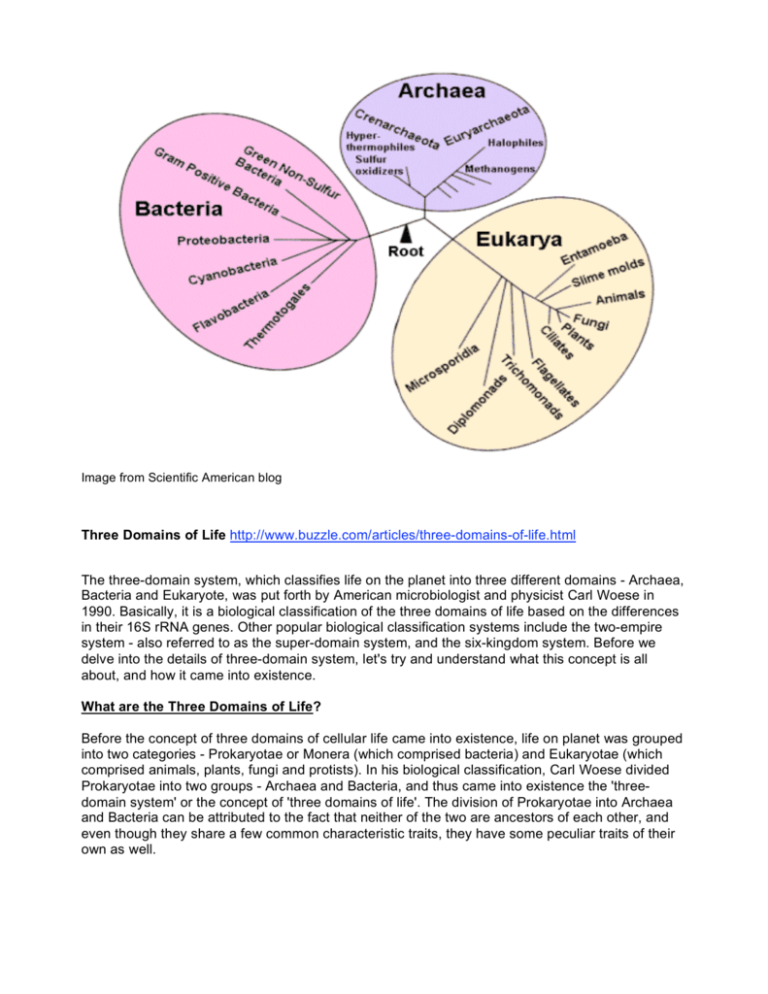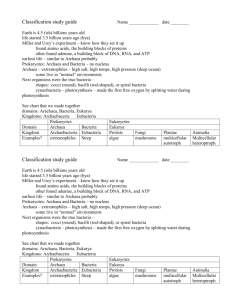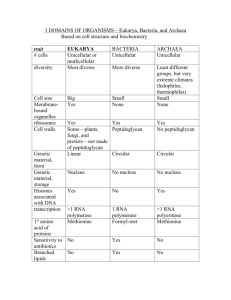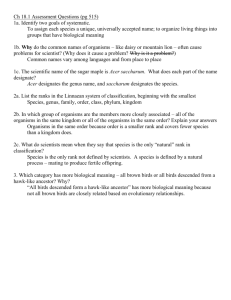Three domains of life
advertisement

Image from Scientific American blog Three Domains of Life http://www.buzzle.com/articles/three-domains-of-life.html The three-domain system, which classifies life on the planet into three different domains - Archaea, Bacteria and Eukaryote, was put forth by American microbiologist and physicist Carl Woese in 1990. Basically, it is a biological classification of the three domains of life based on the differences in their 16S rRNA genes. Other popular biological classification systems include the two-empire system - also referred to as the super-domain system, and the six-kingdom system. Before we delve into the details of three-domain system, let's try and understand what this concept is all about, and how it came into existence. What are the Three Domains of Life? Before the concept of three domains of cellular life came into existence, life on planet was grouped into two categories - Prokaryotae or Monera (which comprised bacteria) and Eukaryotae (which comprised animals, plants, fungi and protists). In his biological classification, Carl Woese divided Prokaryotae into two groups - Archaea and Bacteria, and thus came into existence the 'threedomain system' or the concept of 'three domains of life'. The division of Prokaryotae into Archaea and Bacteria can be attributed to the fact that neither of the two are ancestors of each other, and even though they share a few common characteristic traits, they have some peculiar traits of their own as well. Characteristics of the Three Domains of Life Alongside the three-domain system, there exists a six kingdom system of life, i.e. Archaebacteria (comprising ancient bacteria), Eubacteria (comprising true bacteria), Protista (comprising onecelled organisms), Fungi, Plantae, and Animalia. While Archaebacteria and Eubacteria constitute the Archaea and Bacteria domains respectively, Protista, Fungi, Plantae and Animalia together form the Eukaryote domain of life. Discussed below are the characteristic traits of each of these three domains of life. Archaea Domain: Archaea are prokaryotic cells which are typically characterized by membranes that are branched hydrocarbon chains attached to glycerol by ether linkages. The presence of this ether containing linkages in Archaea adds to their ability of withstanding extreme temperature and highly acidic conditions. Extreme halophiles - i.e. organisms which thrive in highly salty environment, and hyperthermophiles - i.e. the organisms which thrive in extremely hot environment, are best examples of Archaea. Bacteria Domain: Even though bacteria are prokaryotic cells just like Archaea, their membranes are made of unbranched fatty acid chains attached to glycerol by ester linkages. Cyanobacteria and mycoplasmas are the best examples of bacteria. As they don't have ether containing linkages like Archaea, they are grouped into a different category - and hence a different domain. There is a great deal of diversity in this domain, such that it is next to impossible to determine how many species of bacteria exist on the planet. Eukarya Domain: As the name suggests, the Eukaryote are eukaryotic cells which have membranes that are pretty similar to that of bacteria. Eukaryote are further grouped into Kingdom Protista (algae, protozoans, etc.), Kingdom Fungi (yeast, mold, etc.), Kingdom Plantae (flowering plants, ferns, etc.) and Kingdom Animalia (insects, vertebrates, etc.). Not all Eukaryotes have a cell wall, and even if they do they don't contain peptidoglycan as bacteria do. While cells are organized into tissues in case of kingdom Plantae as well as kingdom Animalia, the presence of cell walls is only restricted to the members of kingdom Plantae. Each of these three domains of life recognized by biologists today contain rRNA which is unique to them, and this fact in itself forms the basis of three-domain system. While the presence of nuclear membrane differentiates the Eukarya domain from Archaea domain and Bacteria domain - both of which lack nuclear membrane, the distinct biochemistry and RNA markers differentiate Archaea and Bacteria domains from each other. C. CLASSIFICATION: THE THREE DOMAIN SYSTEM http://faculty.ccbcmd.edu/courses/bio141/lecguide/unit1/3domain/3domain.html The overall purpose of this Learning Object is: 1) to compare the three domains of cellular organisms found in nature; and 2) to learn which of these are prokaryotic and which is eukaryotic. The Earth is 4.6 billion years old and microbial life is thought to have first appeared between 3.8 and 3.9 billion years ago; in fact, 80% of Earth's history was exclusively microbial life. Microbial life is still the dominant life form on Earth. It has been estimated that the total number of microbial cells on Earth on the order of 2.5 X 1030 cells, making it the major fraction of biomass on the planet. Phylogeny refers to the evolutionary relationships between organisms. The Three Domain System, proposed by Woese and others, is an evolutionary model of phylogeny based on differences in the sequences of nucleotides in the cell's ribosomal RNAs (rRNA), as well as the cell's membrane lipid structure and its sensitivity to antibiotics. Comparing rRNA structure is especially useful. Because rRNA molecules throughout nature carry out the same function, their structure changes very little over time. Therefore similarities and dissimilarities in rRNA nucleotide sequences are a good indication of how related or unrelated different cells and organisms are. There are various hypotheses as to the origin of prokaryotic and eukaryotic cells. Because all cells are similar in nature, it is generally thought that all cells came from a common ancestor cell termed the last universal common ancestor (LUCA). These LUCAs eventually evolved into three different cell types, each representing a domain. The three domains are the Archaea, the Bacteria, and the Eukarya. More recently various fusion hypotheses have begun to dominate the literature. One proposes that the diploid or 2N nature of the eukaryotic genome occurred after the fusion of two haploid or 1N prokaryotic cells. Others propose that the domains Archaea and Eukarya emerged from a common archaeal-eukaryotic ancestor that itself emerged from a member of the domain Bacteria. Some of the evidence behind this hypothesis is based on a "superphylum" of bacteria called PVC, members of which share some characteristics with both archaea and eukaryotes. In any event, it is accepted today that there are three distinct domains of organisms in nature: Bacteria, Archaea, and Eukarya. A description of the three domains follows: 1. The Archaea (archaebacteria) The Archaea possess the following characteristics: Archaea are prokaryotic cells. Unlike the Bacteria and the Eukarya, the Archaea have membranes composed of branched hydrocarbon chains (many also containing rings within the hydrocarbon chains) attached to glycerol by ether linkages. • The cell walls of Archaea contain no peptidoglycan. • Archaea are not sensitive to some antibiotics that affect the Bacteria, but are sensitive to some antibiotics that affect the Eukarya. • Archaea contain rRNA that is unique to the Archaea as indicated by the presence molecular regions distinctly different from the rRNA of Bacteria and Eukarya. • • Archaea often live in extreme environments and include methanogens, extreme halophiles, and hyperthermophiles. One reason for this is that the ether-containing linkages in the Archaea membranes is more stabile than the ester-containing linkages in the Bacteria and Eukarya and are better able to withstand higher temperatures and stronger acid concentrations. 2. The Bacteria (eubacteria) The Bacteria possess the following characteristics: • Bacteria are prokaryotic cells. Like the Eukarya, they have membranes composed of unbranched fatty acid chains attached to glycerol by ester linkages. • The cell walls of Bacteria, unlike the Archaea and the Eukarya, contain peptidoglycan. • Bacteria are sensitive to traditional antibacterial antibiotics but are resistant to most antibiotics that affect Eukarya. • Bacteria contain rRNA that is unique to the Bacteria as indicated by the presence molecular regions distinctly different from the rRNA of Archaea and Eukarya. • Bacteria include mycoplasmas, cyanobacteria, Gram-positive bacteria, and Gramnegative bacteria. 3. The Eukarya (eukaryotes) The Eukarya (also spelled Eucarya) possess the following characteristics: Eukarya have eukaryotic cells. Like the Bacteria, they have membranes composed of unbranched fatty acid chains attached to glycerol by ester linkages (see Fig. 1). • Not all Eukarya possess cells with a cell wall, but for those Eukarya having a cell wall, that wall contains no peptidoglycan. • Eukarya are resistant to traditional antibacterial antibiotics but are sensitive to most antibiotics that affect eukaryotic cells. • Eukarya contain rRNA that is unique to the Eukarya as indicated by the presence molecular regions distinctly different from the rRNA of Archaea and Bacteria. • • The Eukarya are subdivided into the following kingdoms: a. Protista Kingdom Protista are simple, predominately unicellular eukaryotic organisms. Examples includes slime molds, euglenoids, algae, and protozoans. b. Fungi Kingdom Fungi are unicellular or multicellular organisms with eukaryotic cell types. The cells have cell walls but are not organized into tissues. They do not carry out photosynthesis and obtain nutrients through absorption. Examples include sac fungi, club fungi, yeasts, and molds. c. Plantae Kingdom Plants are multicellular organisms composed of eukaryotic cells. The cells are organized into tissues and have cell walls. They obtain nutrients by photosynthesis and absorption. Examples include mosses, ferns, conifers, and flowering plants. d. Animalia Kingdom Animals are multicellular organisms composed of eukaryotic cells. The cells are organized into tissues and lack cell walls. They do not carry out photosynthesis and obtain nutrients primarily by ingestion. Examples include sponges, worms, insects, and vertebrates. It used to be thought that the changes that allow microorganisms to adapt to new environments or alter their virulence capabilities was a relatively slow process occuring within an organism primarily through mutations, chromosomal rearrangements, gene deletions and gene duplications. Those changes would then be passed on to that microbes progeny and natural selection would occur. This gene transfer from a parent organism to its offspring is called vertical gene transmission. It is now known that microbial genes are transferred not only vertically from a parent organism to its progeny, but also horizontally to relatives that are only distantly related, eg, other species and other genera. This latter process is known as horizontal gene transfer. Through mechanisms such as transformation, transduction, and conjugation, genetic elements such as plasmids, transposons , integrons, and even chromosomal DNA can readily be spread from one microorganism to another. As a result, the old three-branched "tree of life" in regard to microorganisms now appears to be more of a "net of life." Microbes are known to live in remarkably diverse environments, many of which are extremely harsh. This amazing and rapid adaptability is a result of their ability to quickly modify their repertoire of protein functions by modifying, gaining, or losing their genes. This gene expansion predominantly takes place by horizontal transfer.









